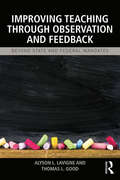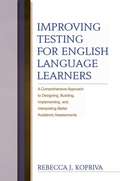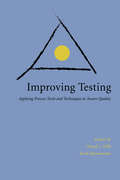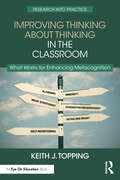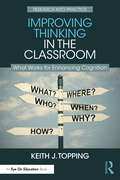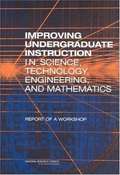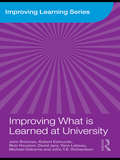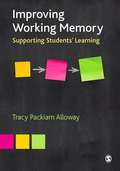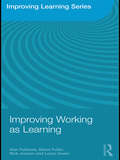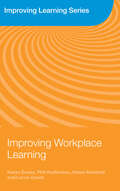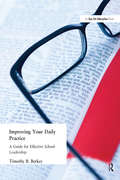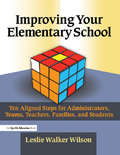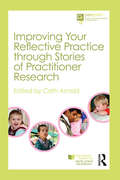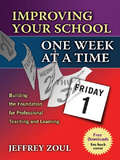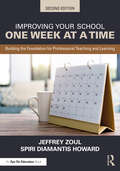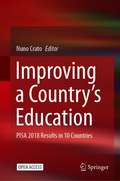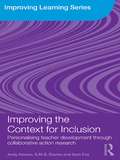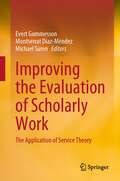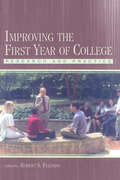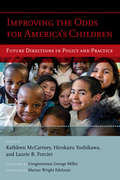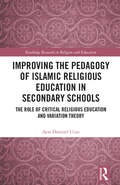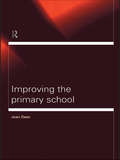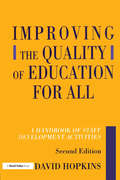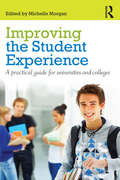- Table View
- List View
Improving Teaching through Observation and Feedback: Beyond State and Federal Mandates
by Alyson L. Lavigne Thomas L GoodIn response to Race to the Top, schools nationwide are rapidly overhauling their teacher evaluation processes. Often forced to develop and implement these programs without adequate extra-institutional support or relevant experience, already-taxed administrators need accessible and practical resources. Improving Teaching through Observation and Feedback brings cutting-edge research and years of practical experience directly to those who need them. In five concise chapters, Thomas Good and Alyson Lavigne briefly outline the history of RttT and then move quickly and authoritatively to a discussion of best practices. This book is a perfect resource for administrators reworking their processes for new evaluation guidelines.
Improving Testing For English Language Learners
by Rebecca KoprivaMore than any book to date, this one provides a comprehensive approach to designing, building, implementing and interpreting test results that validly measure the academic achievement of English language learners. It scaffolds the entire process of test development and implementation and discusses essential intervention points. The book provides the type of evidence-based guidance called for in federal mandates such as the NCLB legislation. Key features of this important new book include the following… Comprehensive – This book recommends methods for properly including ELLs throughout the entire test development process, addressing all essential steps from planning, item writing and reviews to analyses and reporting. Breadth and Depth of Coverage– Coverage includes discussion of the key issues, explanations and detailed instructions at each intervention point. Research Focus – All chapters include an extensive review of current research. Emerging Trends – The chapters summarize guidance appropriate for innovative computer-based assessments of the future as well as the paper-and-pencil tests of today. This book is appropriate for anyone concerned with the development and implementation of fair and accurate testing programs for English language learners. This includes university based researchers, testing personel at the federal, state and local levels, teachers interested in better assessing their diverse student populations and those involved in the testing industry. It is also appropriate for instructors teaching undergraduate and graduate courses devoted to testing the full range of students in todays schools.
Improving Testing: Process Tools and Techniques to Assure Quality
by Cheryl L. Wild Rohit RamaswamyThe primary purpose of this book is to demonstrate how proven quality assurance tools and methods that have been applied successfully in the manufacturing and service industries for the past 20 years can be applied in the testing industry. It defines what is meant by the term "quality" in testing and reviews how three business process concepts – standards, process planning and design, and continuous improvement – can be used to improve the way in which tests are designed, administered, scored and reported so that errors can be eliminated.
Improving Thinking About Thinking in the Classroom: What Works for Enhancing Metacognition
by Keith J. ToppingWhat are the best ways to enhance metacognition in the course of classroom teaching? This research-to-practice book shows how to go beyond simple student reflection to use any of 19 different practical strategies. Each chapter describes a different method, gives the research evidence to support the effectiveness of the method and then provides guidelines for implementation. You will learn about programs within traditional curriculum subjects, programs across the traditional curriculum, programs focusing especially on self-regulation, programs for disabled and special needs students, and programs embedded in a digital environment. You will also discover common features of the methods, so you can see the similarities across the methods and ultimately devise your own ways to develop metacognition and self-regulated learning. With the powerful practices in this book, students will develop a refined ability to think about how they think and learn, preparing them for their futures beyond school.
Improving Thinking in the Classroom: What Works for Enhancing Cognition
by Keith J. ToppingPrograms like philosophy for children, reciprocal teaching, problem based learning and computerized games can help students’ critical and creative thinking skills, but which are most effective? This research-to-practice book showcases how you can improve the thinking (cognition) of your students, across the curriculum and beyond. Each chapter focuses on a particular program, describes the method and background research, offers examples and explains key processes in implementation. You'll learn about thinking programs within a subject, across the curriculum, outside the curriculum and those which can be either within or outside the curriculum, so you can choose a program which suits your context. You’ll also find out what to consider when evaluating a thinking skills program. And finally, you’ll discover shared features of the methods – such as peer interaction, discourse, argumentation, scaffolding and transfer – so you can see the commonalities of the programs and think about designing your own approaches. Whether you’re a classroom teacher, department head, or other key stakeholder, this powerful resource will help you determine what really works for teaching thinking, so your students can apply such skills and thrive long after they’ve left school. Note: This book is part of a set; a companion book focuses on programs for teaching metacognition, or thinking about thinking.
Improving Undergraduate Instruction in Science, Technology, Engineering, and Mathematics: Report of a Workshop
by Richard Mccray Robert L. Dehaan Julie Anne SchuckParticipants in this workshop were asked to explore three related questions: (1) how to create measures of undergraduate learning in STEM courses; (2) how such measures might be organized into a framework of criteria and benchmarks to assess instruction; and (3) how such a framework might be used at the institutional level to assess STEM courses and curricula to promote ongoing improvements. The following issues were highlighted: Effective science instruction identifies explicit, measurable learning objectives. Effective teaching assists students in reconciling their incomplete or erroneous preconceptions with new knowledge. Instruction that is limited to passive delivery of information requiring memorization of lecture and text contents is likely to be unsuccessful in eliciting desired learning outcomes. Models of effective instruction that promote conceptual understanding in students and the ability of the learner to apply knowledge in new situations are available. Institutions need better assessment tools for evaluating course design and effective instruction. Deans and department chairs often fail to recognize measures they have at their disposal to enhance incentives for improving education. Much is still to be learned from research into how to improve instruction in ways that enhance student learning.
Improving What is Learned at University: An Exploration of the Social and Organisational Diversity of University Education (Improving Learning #Vol. 10)
by John Brennan David Jary Michael Osborne Yann Lebeau Robert Edmunds Muir Houston John T.E. RichardsonReceived the ‘highly commended’ award by the Society for Educational Studies for books published in 2010. What is learned in universities today? Is it what students expect to learn? Is it what universities say they learn? How far do the answers to questions such as these differ according to what, where and how one studies? As higher education has expanded, it has diversified both in terms of its institutional forms and the characteristics of its students. However, what we do not know is the extent to which it has also diversified in terms of ‘what is learned’. In this book, the authors explore this question through the voices of higher education students, using empirical data from students taking 15 different courses at different universities across three subject areas – bioscience, business studies and sociology. The study concentrates on the students’ experiences, lives, hopes and aspirations while at university through data from interviews and questionnaires, and this is collated and assessed alongside the perspectives of their teachers and official data from the universities they attend. Through this study the authors provide insights into ‘what is really learned at university’ and how much it differs between individual students and the universities they attend. Notions of ‘best’ or ‘top’ universities are challenged throughout, and both diversities and commonalities of being a student are demonstrated. Posing important questions for higher education institutions about the experiences of their students and the consequences for graduates and society, this book is compelling reading for all those involved in higher education, providing conclusions which do not always follow conventional lines of thought about diversity and difference in UK higher education.
Improving Working Memory
by Tracy Packiam AllowayYour working memory is the information your brain stores for a short period of time, it is your brain's post-it note if you like, and how much information you can remember has a huge influence on how well you do at school, and beyond. By understanding a child's working memory, you will be able to support their learning at school, and their concentration. Better working memory can be particularly useful to children with conditions where poor working memory is thought to be an underlying factor. Such conditions include: - dyslexia - dyscalculia - speech and language difficulties - developmental coordination disorders (motor dyspraxia) - ADHD (attention deficit hyperactivity disorder) - autistic spectrum disorders This book explains how to spot problems early, and how to work with children to improve their working memory, therefore increasing their chances of success in the classroom. It also explains the theory behind working memory. Underpinned by rigorous research and written in a highly accessible style, this book will appeal to practitioners, parents and students as an essential guide to helping their students fulfil their maximum potential.
Improving Working as Learning (Improving Learning)
by Nick Jewson Lorna Unwin Alison Fuller Alan FelsteadInterest in learning at work has captured the attention of many people around the world, often taking centre stage in policy debates about improving economic performance, prosperity and well-being. This book is about the learning that goes on in workplaces – ranging from offices, factories and shops to gyms, health centres and universities – and how it can be improved. Such learning includes everyday work activity, on-the-job instruction and off-the-job training events. Improving Working as Learning is the first book to analyze systematically learning at work in different settings by developing and applying a new analytical framework. The Working as Learning Framework connects the particularities of work tasks with the way jobs are organized and the wider pressures and constraints organizations face for survival, growth and development. The authors convincingly demonstrate that the framework offers a sophisticated understanding of how improving the work environment – both within the workplace and beyond – can enhance and sustain improvements in learning at work. Each chapter presents evidence – taken from both private and public sectors – to illustrate how the Working as Learning Framework provides a means by which employers, researchers and policy-makers can Improve the conditions for nurturing and sustaining learning at work Build appropriate workforce development plans within given constraints Recognize that the creation and use of knowledge is widely distributed Mobilize existing workplace resources to support learning Enhance and extend our understanding of how workplace learning is shaped by relationships at, and beyond, the workplace This topical book will appeal to an international readership of undergraduate and postgraduate students, vocational teachers and trainers, human resource professionals, policy-makers, and researchers.
Improving Workplace Learning (Improving Learning)
by Karen Evans Lorna Unwin Phil Hodkinson Helen RainbirdAcross the western world, there is a growing awareness of the importance of workplace learning, seen at the level of national and international policy, as well as in the developing practices of employers, training providers and Trades Unions. Authoritative, accessible, and appealing, it presents key findings on work-based learning, bringing together conclusions and investigating a variety of workplace contexts to show how such learning can be improved. An extensive practical treatment, brought to life with illustrations from both the public and private sectors, this book has a unique combination of breadth of coverage and depth of understanding. Grounded in rich and detailed empirical studies, this volume challenges conventional thinking. An important new addition to the Improving Learning series, it focuses on guidelines for improving learning by marrying the very best theory and practice to provide an accessible and authoritative guide to workplace learning. Practitioners, policy makers, students and academics with an interest in learning at work will find this an invaluable addition to their bookshelves.
Improving Your Daily Practice: A Guide for Effective School Leadership
by Tim BerkeyThis book will show principals how they can change daily practices to invest more time in the improvement of teaching and learning. It redirects leadership to effective practices in instructional leadership.
Improving Your Elementary School: Ten Aligned Steps for Administrators, Teams, Teachers, Families, and Students
by Leslie Walker WilsonEach of the chapters in this unique book wa written expressly for each major stakeholder group in your school, tailored to their varied needs and experiences. Each chapter contains a set of inter-related practical activities so that each group focuses on the same goals and supports the others. No other book on school improvement includes a chapter written exclusively for elementary students, printed in large type, illustrated with cartoons, and accompanied by step-by-step advice for educators on how to use this material.
Improving Your Reflective Practice through Stories of Practitioner Research (Pen Green Books for Early Years Educators)
by Cath ArnoldImproving Your Reflective Practice through Stories of Practitioner Research shows how research has informed and created effective and valuable reflective practice in early years education, and offers depth to the arguments for a research-orientated stance to this vital field of study. This thought-provoking text explores and documents a variety of small-scale practitioner research projects from the home and early years settings. The stories are centred around real life for children, families and workers and offer practical ideas and support for early years students around the world. They engage in some of the most current debates in early childhood education today, such as: how to support children as individuals how young children learn and how parents support their learning how to lead and facilitate change in a way that does not take power away from children, parents or workers how to support children in taking risks how to support parents in returning to learning. Throughout this book, the ‘Pen Green’ attitude to practitioner research is actively encouraged. This involves fostering curiosity, being open to the views of others, questioning the ‘taken for granted’, making the implicit explicit and reflecting on one’s daily work. Any practitioner research in early years education and care will draw inspiration from this accessible and supportive text.
Improving Your School One Week at a Time: Building the Foundation for Professional Teaching and Learning
by Jeffrey ZoulThis book displays 37 “Friday Focus” memos, each of which provides insight into a specific aspect of teaching and learning for all to reflect on throughout the year. Friday Focus memos address the principal’s responsibility to shape the school culture, provide intellectual stimulation, and communicate effectively. The memos are organized around the school year and provide educators with a wide variety of insights into how to improve our schools. They are typically between 500–1,000 words in length and can be sent out via e-mail to each staff member – not only to the teachers but also secretaries, custodians, and cafeteria workers. A vehicle for school improvement, the Friday Focus memos provide a step-by-step plan for staff members and principals to work together as change agents for school improvement.
Improving Your School One Week at a Time: Building the Foundation for Professional Teaching and Learning
by Jeffrey Zoul Spiri Diamantis HowardLearn how you can work more effectively with your staff to improve your school. In this unique book, Jeffrey Zoul and Spiri Diamantis Howard reveal how a powerful tool, “Friday Focus” emails or newsletters, can help school principals communicate more proactively and consistently with their teachers while improving instruction and morale.The chapters cover 37 “Friday Focus” memos, which are organized around the school year and which cover topics such as student behavior, teacher observations, parent-teacher conferences, and more. This updated second edition offers suggestions for additional areas including artificial intelligence and equity, hope, microlearning, universal design for learning, engaging the families of ELLs, online relationship building, and gamification.Whether you’re a new or veteran school leader, these inspiring messages will help you work alongside your staff as change agents for school improvement.
Improving a Country’s Education: PISA 2018 Results in 10 Countries
by Nuno CratoThis open access book compares and contrasts the results of international student assessments in ten countries. The OECD’s Programme for International Student Assessment (PISA) released the results of its 2018 assessment in December 2019. This book reflects the debates that typically follow the release of these results and focuses on the causes of differences between countries. Such causes include continuous decline in one country, improvement combined with increasing internal inequalities in another country, or rapid improvement in spite of an outdated curriculum in yet another.In addition, the book discusses a number of general questions: Is knowledge outdated? Are computers taking over and replacing teachers? Are schools killing creativity? Are we adequately preparing the next generation? Are schools failing to educate our kids? The book starts out with a summary of PISA’s evolution and PISA results, and an explanation of the major factors that play a role in changes in countries’ results. The next ten chapters are devoted to ten specific countries, offering a summary of data and an explanation of the major drives for changes in education results for each one. Each chapter includes a short description of the country’s educational system as well as the impact of PISA and other ILSA studies on the country’s educational policies. The chapters also include a timeline of policy measures and main hallmarks of the country’s educational evolution, discussing the impact of these measures on its PISA results. A final reference chapter explains what PISA is, what it measures and how. While highlighting the 2018 results, the book also takes into consideration previous results, as well as long-term initiatives.This book gathers the contribution of well-known and respected experts in the field. Specialists such as Eric Hanushek, for the US, Tim Oates, for England, Montse Gomendio, for Spain, Gunda Tire, for Estonia, and all other contributors draw on their vast experience and statistical analysis expertise to draw a set of rich country lessons and recommendations that are invaluable for all of those who care about improving a country’s education system.
Improving the Context for Inclusion: Personalising Teacher Development through Collaborative Action Research (Improving Learning)
by Sam Fox Andy Howes S.M.B. DaviesThis timely book addresses the need for increasing multi-agency capacity in schools, as the success of initiatives such as ‘Every Child Matters’ or ‘personalised learning’ depends on teachers understanding the challenges faced by young people in learning effectively and happily in their school. The authors of this thought-provoking book present and analyse case studies of collaborative action research, illustrating what is needed in practice for teachers to engage with inclusion for the benefit of their pupils and themselves. The essential elements of success with inclusion are revealed, including: the importance of identifying issues that teachers see as relevant; how teachers can achieve meaningful collaboration in addressing the issues; the necessity of paying careful attention to the consequences of the changes that they make; incorporating practical considerations such as critical support from outsiders; the role of facilitators such as educational psychologists in working with groups of teachers to support their development through action research; how to facilitate change through making use of resources that are already available in the education system. Improving the Context for Inclusion is fascinating reading for all students of education, especially those with an interest in inclusion. Teachers, school leaders and those working in education services will gain an invaluable insight in to how to create an inclusive school environment.
Improving the Evaluation of Scholarly Work: The Application of Service Theory
by Michael Saren Evert Gummesson Montserrat Díaz-MéndezThis book aims to stimulate debate in the growing and highly controversial area of measuring scholarly work. The authors examine key aspects of this topic through the lens of the latest theoretical developments in service science and associated fields. It includes chapters explaining the theoretical developments and methodological aspects of measuring the quality of academic teaching and research, while other chapters provide a review and analysis of various types of scholarly work metrics and processes with examples from several countries, cultures, and educational systems. The current growing concern about higher education (HE) quality has prompted institutions to divide university teachers’ work into different areas and to design methods aimed at measuring the productivity of these areas. It is widely accepted that the need to evaluate HE service quality is a relevant issue for any society. However, the authors argue that most of the current practices used in the pursuit of this objective are jeopardizing the future of the university as a place of knowledge generation, science evolution and professional education.
Improving the First Year of College: Research and Practice
by Robert S. FeldmanThe first year of college represents an enormous milestone in students' lives. Whether attending a four-year or two-year institution of higher education, living on campus or at home, or enrolled in a highly selective school or a college with an open-admissions policy, students are challenged in unique and demanding ways during their first year.Although many students rise to the challenges they face, for some the demands are too great. Retention rates beyond the first year are disappointing: one third of first-year students seriously consider leaving college during their first term, and ultimately one half of all students who start college complete it.What are the factors that impact students during their first year? How can the academic and social experiences of first-year students be optimized? What can we do to improve retention rates to maximize the number of students who complete college? Improving the First Year of College employs a variety of perspectives from leading researchers and student-service providers to address these questions and examine the first year of college.This volume also highlights the development of learning communities and coaching, as well as how technology impacts students' first year. Perhaps most important, the book provides examples of "best practices," as determined through research by leaders in the field, to permit educators to draw on their experiences.
Improving the Odds for America's Children: Future Directions in Policy and Practice
by Marian Wright Edelman George Miller Kathleen Mccartney Hirokazu Yoshikawa Laurie B. ForcierThis landmark volume commemorates the fortieth anniversary of the Children’s Defense Fund, which has been an uncompromising champion of American youth for all of those years. Yet the book looks not to the past but at our current circumstances—and at the challenges we must meet now and in the future on behalf of our young people. The book examines critical issues—prenatal and infant health and development, early child care and education, school reform, the achievement gap, vulnerable children, juvenile justice, and child poverty—and highlights crucial practical and policy measures we need to consider and undertake if we are to better serve American children. An invaluable survey of the conditions facing American youth—and a call to action at the local, state, and national levels—Improving the Odds for America’s Children is an urgent, informative, and inspired volume that addresses shortcomings and challenges we cannot afford to ignore. Contributors include Sara Rosenbaum, Partow Zomorrodian, Jack P. Shonkoff, Joan Lombardi, Deborah Jewell- Sherman, Jal Mehta, Robert B. Schwartz, Jerry D. Weast, Greg J. Duncan, Richard J. Murnane, Michael S. Wald, Jane Waldfogel, Robert G. Schwartz, Laurence Steinberg, Arloc Sherman, Robert Greenstein, Sharon Parrott, and Eric Dearing.
Improving the Odds for America's Children: Future Directions in Policy and Practice
by Marian Wright EdelmanThis landmark volume commemorates the fortieth anniversary of the Children&’s Defense Fund, which has been an uncompromising champion of American youth for all of those years. Yet the book looks not to the past but at our current circumstances—and at the challenges we must meet now and in the future on behalf of our young people. The book examines critical issues—prenatal and infant health and development, early child care and education, school reform, the achievement gap, vulnerable children, juvenile justice, and child poverty—and highlights crucial practical and policy measures we need to consider and undertake if we are to better serve American children. An invaluable survey of the conditions facing American youth—and a call to action at the local, state, and national levels—Improving the Odds for America&’s Children is an urgent, informative, and inspired volume that addresses shortcomings and challenges we cannot afford to ignore. Contributors include Sara Rosenbaum, Partow Zomorrodian, Jack P. Shonkoff, Joan Lombardi, Deborah Jewell- Sherman, Jal Mehta, Robert B. Schwartz, Jerry D. Weast, Greg J. Duncan, Richard J. Murnane, Michael S. Wald, Jane Waldfogel, Robert G. Schwartz, Laurence Steinberg, Arloc Sherman, Robert Greenstein, Sharon Parrott, and Eric Dearing.
Improving the Pedagogy of Islamic Religious Education in Secondary Schools: The Role of Critical Religious Education and Variation Theory (Routledge Research in Religion and Education)
by Ayse Demirel UcanThis timely book focusses on the central issues and questions which emerge in relation to the teaching and learning of Islam in confessional and constructivist religious education. Considering the consequences of a lack of diversity in the Islamic Religious Education curriculum, the text also explores the challenges faced by Muslim pupils in connection with secularism and radical Islam. Through rich analysis of research carried out across Muslim and public secondary schools in the UK, this book develops a meaningful pedagogy of Islamic Religious Education. In particular, the volume investigates the benefits of Critical Religious Education and Variation Theory frameworks on student learning in Religious Education classrooms and illustrates how these didactic frameworks can help to ameliorate distinct problems seen across Islamic Religious Education. Chapters identify discrete pedagogical issues that arise in the confessional and constructivist approaches to Islamic Education, such as students’ difficulties in relating to concept of Islam, and progressive approaches taken in public schools. In addressing these, the text proposes a new theoretical and pedagogical approach to the teaching of Islam, which draws on the philosophy of Critical Realism, the theories of Critical Religious Education, and Variation Theory. This book will be of great interest to postgraduate students, researcher scholars and academics in the fields of religion and education and Islamic studies. In addition, it will be of interest to social equity professionals and public policy decision makers.
Improving the Primary School: Effective Teaching In The Primary School
by Joan Dean Mrs Joan DeanThis book is a practical and informative guide on how to improve your primary school. It is aimed at those in leadership positions: headteachers, senior staff, advisors, inspectors and education officers. Aimed specifically at the primary school, this book: * links research to classroom practice for results * appeals to those in leadership roles * is concise, readable and of great practical use * provides the reader with information that can improve the individual school.
Improving the Quality of Education for All: A Handbook of Staff Development Activities
by David HopkinsThe "Improving the Quality of Education for All" (IQEA) school improvement project has, over the last ten years, reduced and evaluated a model of development that strengthens the school's ability to provide high quality education for all its pupils by building on existing good practice. The schools within the IQEA network have also provided the setting for a long-term investigation into the processes of school change and the enhancement of student achievement. This book provides many practical staff development activities and gives examples of specific changes which have taken place in IQEA schools, relating both to the progress of students and the professional development of their teachers. These training activities and examples demonstrate that improving the quality of education has many facets, not all of which can be measured and translated into league tables.
Improving the Student Experience: A practical guide for universities and colleges
by Michelle MorganThe landscape of higher education (HE) has dramatically altered in the past 30 years and it continues to evolve and change. More students are entering HE and attending university or college on a global scale than ever before. Supporting and enhancing the undergraduate student experience across the student lifecycle, from first contact through to alumni, is a critical activity in higher education today not only to aid retention and progression but in a highly competitive HE market, the quality of the student experience is pivotal to an institution’s ability to attract students. The student experience encompasses all aspects of student life, i.e. academic, social, welfare, with the academic imperative at the heart of it. However, the increasing costs of delivering HE, a reduction in government/ state funding and constraints on resources means delivering a quality student experience has never been more challenging for those working in HE. Staff at all levels, and across all areas within an institution, are developing and implementing initiatives to improve and enhance the student experience whether they are at the coal face or on the periphery thus making them a ‘Practitioner’ in the student experience. This could include the admissions administrator improving the information available for potential applicants; the academic improving his/her feedback to students or central welfare departments ensuring that their services are being advertised and supported within a student’s home unit (faculty/department/school/course). In this book, the Editor, Michelle Morgan describes how her new student experience ‘Practitioner Model’ provides an organised and more detailed structure; guiding Practitioners in the identification of what they have to deliver, who they need to deliver it to and when they need to deliver it across her six key stages of the student lifecycle: · First Contact and Admissions; · Pre-arrival; · Arrival and Orientation; · Induction to Study; · Reorientation and Reinduction (Returners' Induction) · Outduction (preparation for life after undergraduate study). The Practioner Model offers a new way of thinking in terms of delivering ‘interlinked’ academic, welfare and support activities at the home unit and university level to support the student in their university journey. This book also provides working solutions to real problems in the form of exemplar case studies from the UK and internationally, including chapters from Liz Thomas, Di Nutt, Marcia Ody, Chris Keenan(UK), Mary Stuart Hunter, (USA), Kerri-Lee Krause and Duncan Nulty (Australia). Good practice must be adaptable and transferable because one size does not fit all. It must also be cost effective. And here the authors shows how practitioners can adapt and customise the 40 case studies presented to help them not only improve and enhance the experience of their undergraduate students in their own institution (both full and part-time) but also to support their students’ progression and retention.
